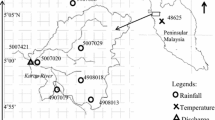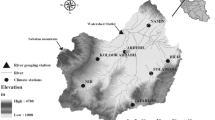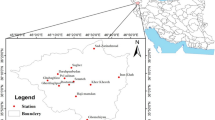Abstract
Until recently, hydrological impacts and prediction caused by climate change have been popular issues. However, a basin-scale hydro-environmental study has begun to attract attention recently due to the difficulties in watershed model calibration and uncertainty propagation in the data relaying procedure from the GCM (General Circulation Model) process to watershed modeling process, which leads to unrealistic projections. In addition, reliable downscaling scheme is essential in utilizing the GCM model output for hydrological applications. The main objective of this study is to suggest a reliable ANN (Artificial Neural Network)-based GCM scenario and its application for hydro-environmental projection using a watershed model. In this report, the Namgang Dam watershed in the Nakdong river basin was selected as the case study. To examine the vulnerability of the Namgang dam watershed caused by climate change, the change in streamflow and pollutant material runoff due to climate change were predicted using the watershed model, SWAT (Soil Water Assessment Tool), based on the IPCC’s A1B GCM scenario, which is downscaled using the ANN and Nonstationary Quantile Mapping. The results of this study will be used for suggesting an effective counterplan from an engineering point of view, and developing an integrated water sources management system.
Similar content being viewed by others
References
ASCE (1993). “Criteria for evaluation of watershed models.” J. Irrigat. Drain. Eng., Vol. 119, No. 3, pp. 429–442, DOI: 10.1061/(ASCE)0733-9437(1993)119:3(429).
Dong, W., Cui, B., Liu, Z., and Zhang, K. (2014). “Relative effects of human activities and climate change on the river runoff in an arid basin in northwest China.” Hydrological Processes, Vol. 28, No. 18, pp. 4854–4864, DOI: 10.1002/hyp.9982.
Elfert, S. and Bormann, H. (2010). “Simulated impact of past and possible future land use changes on the hydrological response of the Northern German lowland ‘Hunte’ catchment.” Journal of Hydrology, Vol. 383, Nos. 3–4, pp. 245–255, DOI: 10.1016/j.jhydrol.2009.12.040.
Harpham, C. and Wilby, R. L. (2005). “Multi-site downscaling of heavy daily precipitation occurrence and amounts.” J. Hydrol, Vol. 312, Nos. 1–4, pp. 235–255DOI: 10.1016/j.jhydrol.2005.02.020.
Hashino, T., Bradley, A. A., and Schwartz, S. S. (2007). “Evaluation of bias-correction methods for ensemble streamflow volume forecasts.” Hydrol. Earth Syst. Science, Vol. 11, No. 2, pp. 939–950, DOI: 10.5194/hess-11-939-2007.
Haykin, S. (1994). Neural networks: A comprehensive foundation, Macmillan, New York.
IPCC (2001). Climate Change 2001: The scientific basis, Contribution of working group I to the third assessment report of the Intergovernmental Panel on Climate Change, Cambridge University Press, Cambridge, UK, DOI: 10.1256/004316502320517344.
Khoi, D. N. and Suetsugi, T. (2014). “Impact of climate and land-use changes on hydrological processes and sediment yield-a case study of the Be River catchment, Vietnam.” Hydrological Sciences Journal, Vol. 59, No. 5, pp. 1095–1108, DOI: 10.1080/02626667.2013.819433.
Legates, D. R. and McCabe, G. J. (1999). “Evaluating the use of goodness-of-fit measures in hydrologic and hydroclimatic model validation.” Water Resour. Res., Vol. 35, No. 1, pp. 233–241, DOI: 10.1029/1998WR900018.
Leung, L. R., Hamlet, A. F., Lettenmaier, D. P., and Kumar, A. (1999). “Simulations of the ENSO hydroclimate signals in the Pacific Northwest Columbia River basin.” Bull. Amer. Meteorol. Soc., Vol. 80, No. 11, pp. 2313–2328, DOI: 10.1175/1520-0477(1999)080 <2313:SOTEHS>2.0.CO;2.
Manguerra, H. B. and Engel, B. A. (1998). “Hydrologic parameterizatin of watersheds for runoff prediction using SWAT.” J. Am. Water Resour. Assoc., Vol. 34, No. 5, pp. 1149–1162, DOI: 10.1111/j.1752-1688.1998.tb04161.x.
Maraun, D., Wetterhall, F., Ireson, A. M., Chandler, R. E., Kendon, E. J., Widmann, M., Brienen, S., Rust, H. W., Sauter, T., Themeßl, M., Venema, V. K. C., Chun, K. P., Goodess, C. M., Jones, R. G., Onof, C., Vrac, M., and Thiele-Eich, I. (2010). “Precipitation downscaling under climate change: Recent developments to bridge the gap between dynamical models and the end user.” Rev. Geophys., Vol. 48, No. 3, pp. 1–38, DOI: 10.1111/j.1752-1688.1998.tb04161.x.
Mendes, D. and Marengo, J. A. (2010). “Temporal downscaling: a comparison between artificial neural network and autocorrelation techniques over the Amazon Basin in present and future climate change scenarios.” Theoretical and Applied Climatology, Vol. 100, Nos. 3–4, pp. 413–421, DOI: 10.1007/s00704-009-0193-y.
Mpelasoka, F. S., Mullan, A. B., and Heerdegen, R. G. (2001). “New zealand climate change information derived by multivariate statistical and artificial neural networks approaches.” Int. J. Climatol, Vol. 21, No. 11, pp. 1415–1433, DOI: 10.1002/joc.617.
Nadler, M. and Smith, E. P. (1993). Pattern recognition engineering, Wiley, New York.
Nash, J. E. and Sutcliffe, J. V. (1970). “River flow forecasting through conceptual models: Part I. A discussion of principles.” J. Hydrol, Vol. 10, No. 3, pp. 282–290, DOI: 10.1016/0022-1694(70)90255-6.
Santhi, C., Arnold, J. G., Williams, J. R., Dugas, W. A., and Hauck, L. (2001). “Validation of the SWAT model on a large river basin with point and nonpoint sources.” J. Am. Water Resour. Assoc., Vol. 37, No. 5, pp. 1169–1188, DOI: 10.1111/j.1752-1688.2001.tb03630.x.
Schmidli, J., Frei, C., and Vidale, P. L. (2006). “Downscaling from GCM precipitation: A benchmark for dynamical and statistical downscaling methods.” Int. J. Climatol, Vol. 26, No. 5, pp. 679–689, DOI: 10.1002/joc.1287.
Schoof, J.T. and S.C. Pryor. (2001). “Downscaling temperature and precipitation: A comparison of regression-based methods and artificial neural networks.” International Journal of Climatology, Vol. 21, No. 1, pp. 773–790, DOI: 10.1002/joc.655.
Trigo, R. M. and Palutikof, J. P. (2001). “Precipitation scenarios over iberia: A comparison between direct GCM output and different downscaling techniques.” J. Climate, Vol. 14, No. 23, pp. 4422–4446, DOI: 10.1175/1520-0442(2001)014<4422:PSOIAC>2.0.CO;2.
Tsoukalas, L. H. and Uhrig, R. E. (1997). Fuzzy and neural approaches in engineering, Wiley, New York.
USEPA (2001). Better assessment science integrating point and nonpoint sources, Office of Science and Technology, EPA 823-B-01-001, USEPA, Washington, DC.
Van Liew, M. W. and Garbrecht, J. (2003). “Hydrologic simulation of the little washita river experimental watershed using SWAT.” J. Am. Water Resour. Assoc., Vol. 39, No. 2, pp. 413–426, DOI: 10.1111/j.1752-1688.2003.tb04395.x.
Wilby, R. L., Wigley, T., Conway, D., Jones, P., Hewitson, B., Main, J., and Wilks, D. (1998). “Statistical downscaling of general circulation model output: A comparison of methods.” Water Resources Research, Vol. 34, No. 11, pp. 2995–3008, DOI: 10.1029/98WR02577.
Wood, A. W., Leung, L. R., Sridhar, V., and Lettenmaier, D. P. (2004). “Hydrologic implications of dynamical and statistical approaches to downscaling climate model outputs.” Climatic Change, Vol. 62, Nos. 1–3, pp. 189–216, DOI: 10.1023/B:CLIM.0000013685.99609.9e.
Wood, A. W., Maurer, E. P., Kumar, A., and Lettenmaier, D. P. (2002). “Long-range experimental hydrologic forecasting for the eastern United States.” J. Geophys. Res.-Atmos, Vol. 107, No. D20, 4429, DOI: 10.1029/2001JD000659.
Zhang, A., Zhang, C., Fu, G., Wang, B., Bao, Z., and Zheng, H. (2012). “Assessments of impacts of climate change and human activities on runoff with SWAT for the huifa river basin, northeast China.” Water Resources Management, Vol. 26, No. 8, pp. 2199–2217, DOI: 10.1007/s11269-012-0010-8.
Author information
Authors and Affiliations
Corresponding author
Rights and permissions
About this article
Cite this article
Kang, B., Kim, Y.D., Lee, J.M. et al. Hydro-environmental runoff projection under GCM scenario downscaled by Artificial Neural Network in the Namgang Dam watershed, Korea. KSCE J Civ Eng 19, 434–445 (2015). https://doi.org/10.1007/s12205-015-0580-0
Received:
Revised:
Accepted:
Published:
Issue Date:
DOI: https://doi.org/10.1007/s12205-015-0580-0




